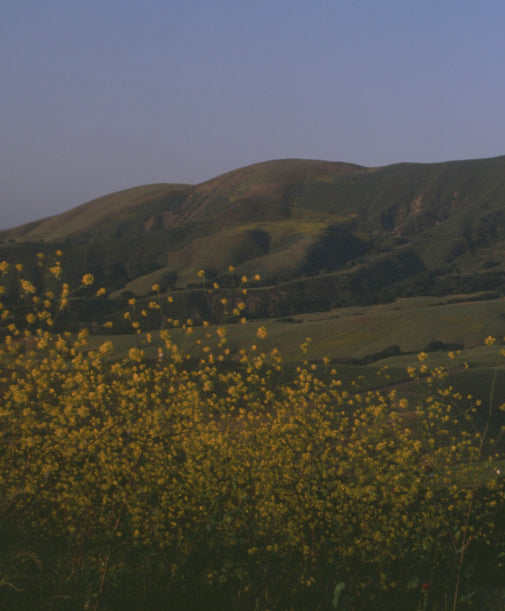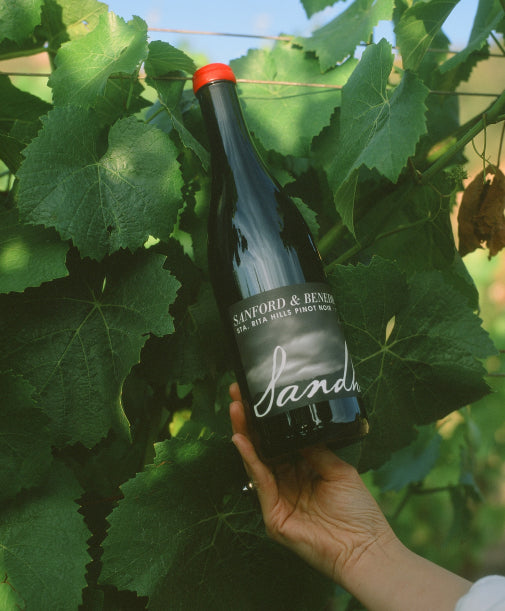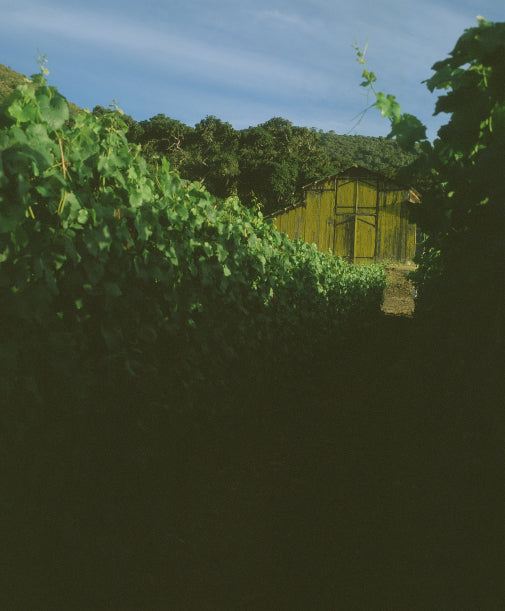
Sta. Rita Hills, 2023

Sunset in the Sta. Rita Hills

Sanford & Benedict Pinot Noir

Sanford & Benedict Vineyard
The single-vineyard wines of Sandhi zoom in on an exceptionally narrow band of the Santa Rita Hills with precision that matches the wines themselves. Each single-vineyard bottling hails from classic sites south of Santa Rosa Road, along the Santa Rita Hills’ southern corridor. This is no accident. The bumpy, meandering east-west two-lane mottled with mud and choked by coast oaks and California sage is the ideological and viticultural birthplace of Sandhi.
These north-facing vineyards on an ancient seabed mere miles from the present-day ocean captured Rajat’s attention many years ago. “I had tasted a lot of wine from the area and my favorite wines were from Santa Rosa Road, so we decided to focus Sandhi only on Santa Rosa Road. That’s the reason I’m fascinated with it. I think it defines the Santa Rita Hills."
Sanford & Benedict
When they planted this gentle, north-facing slope lodged between the Santa Rosa Hills and the road of the same name, Richard Sanford & Michael Benedict had little idea they’d be making not just wine, but history. Armed with little more than Benedict’s botany degree, Sanford’s amateur climate data and rugged intuition, the two became the first to stick vines this close to the western Santa Barbara County coast. They were called crazy for doing so. “Can you imagine – there are no vineyards around, and you plant your first vineyard in the middle of nowhere?”, Raj muses with wonder. Nowadays, Sanford & Benedict is arguably the lifeblood of the very region, and it’s the place that brought him to the Santa Rita Hills nearly 20 years ago. “When I first decided to make wine in Santa Barbara County, I had tasted a lot of wines from the area, and my favorite wines were always from Sanford & Benedict.” The 2023 vintage will be his 20th crafting Sanford & Benedict Chardonnay.
This vineyard marks a pivotal point in Santa Barbara County winegrowing. Planted in 1971 to an olio of grapes from Cabernet Sauvignon to Riesling to Merlot, its longevity and success are largely the result of great risk, trial and error, and quite frankly, none of the above grapes working out. It’s important to note that just 50 years ago, this area totaled maybe six commercial vineyards. Literal fruit salad experiments like Sanford & Benedict’s were de rigueur throughout California–no one really knew what they were doing, so why not throw everything at the wall to see what sticks –and yielded wines ranging from inspirational to inedible. But in a stroke of genius, sheer luck or some combination of the two, the great grapes of Burgundy, not yet in vogue in 1971, were also planted at Sanford & Benedict. Within five years the site would earn recognition for its fine Chardonnay and Pinot Noir. Few vineyards here have held such consistent acclaim since.
There’s no simple explanation why. To be sure, its own-rooted vines are sought after by just about every producer of Pinot Noir and Chardonnay this side of Monterey Bay. And like many of the world’s premier vineyards, its terroir is fascinating. Mixed slope wash from an ancient landslide and flooded alluvial material scatter the ground with fractured pieces of chert, shale and diatomaceous earth–a testament to the influence of ocean, mountain and river found here. These elements, combined with historical vines and the coastal breezes that nuzzle them, yield an effortlessly fresh and saline wine.
Raj sums up the classic Sanford & Benedict profile. “It has that kind of briny oyster shell, lemon curd, very austere at first. It always needs time to show itself... it’s never going to be a fruit-forward wine.”
Patterson
Heading west from the town of Buellton, Patterson Vineyard is the first of Sandhi’s vineyard sites, and 2021 is just the fourth bottling of this cuvée from Pinot Noir grafted to Chardonnay. Its salience lies in unique vines–by way of Burgundy via Dominique Lafon, famed vigneron in his own right and consultant for Evening Land Vineyards – and a steep exposure at significant elevation, where these vines find more sunlight and protection from howling winds further west. That intense sunlight is mitigated by a north-facing slope, however, and the vineyard’s clay-loam soils hold moisture and contribute to the density of fruit and mouthfeel that have become hallmarks of Patterson. There’s a textural component to this wine that uncoils its more tightly-wound qualities into a delightful presentation. It’s as if this French plant material is slowly and slyly revealing itself to more friendly California terroir. The balancing act is a successful one.
with bentrock the stars aligned
La Rinconada
A few more minutes past Patterson, the dramatic southern hillsides along Santa Rosa Road continue to unfurl. This is truly the heart of the Santa Rita Hills and vines blanket both sides of Santa Rosa Road as La Rinconada comes into view. Due west of the famed Sanford & Benedict Vineyard, Rinconada was planted in 1997 to the very same grape varieties by some of the very same hands. Yet the land itself is quite different. Sanford & Benedict’s old, openly-spaced vines sit atop fractured pieces of shale with flintstone, and while standing in it you could easily launch one of those stones right into Rinconada–it's next door–there the rock would collide with much heavier soils and much denser vines. Though rooted in moisture-retaining clay, the vines were planted tightly to foster more competition for nutrients and grow more concentrated grapes. These factors all contribute to Rinconada’s dense and rich while still acid-driven expression of Chardonnay.
Romance
Asking why–or why not–has informed Raj’s nearly three-decade career every step of the way. At the edge of a growing region and a continent, these questions grow louder in both directions. This is the backdrop for Romance Chardonnay.
Romance Vineyard sits directly below the vineyards of Domaine de la Côte, a factor as responsible for its Chardonnay’s distinction as any. It shares the same uplifted alluvial soils and Monterey shale that grace the Memorious and Bloom’s Field parcels and lend those wines their taut structure and perfume. Above ground they are blanketed with relentless wind and, especially at Romance Vineyard, low-lying fog. Yet Romance sits on a south-facing slope that boosts the cool but bright refrigerated sunlight imbedded in this part of the coast.
This site receives special attention in its farming. While most of our cuvées are sourced from purchased grapes, Romance is the only parcel of estate Sandhi Chardonnay, planted and lovingly tended to by our dear friend Chris King of Cosecha Farming.
At just ten miles from the coast, this is harsh, maritime viticulture, and the vines are encouraged not to grow ample fruit but rather coexist with these conditions. As a result, yields remain low–locking in deep flavor over the long growing season–and very little wine is made. Raj enjoys this naturally small production for more than just wine quality. “You definitely feel small lots. It’s the connection you have with the grapes. You have a complete connection with the wine.”
Cold, windy and nearly inhospitable to any crop, most farmers wouldn’t dare grow vines in this place. There’s a reason nothing was planted here prior – only cattle touched these hills. But that is precisely why we chose this place. This story is young; the 2021 Romance is just the third bottling of the cuvée. Raj looks with both eyes towards the future. “This is a young vineyard with lots of potential,” he smiles.
Bentrock
As you reach Bentrock, temperatures have dropped, winds have picked up
and vineyards have begun to make way for row crops and walnut trees. It quickly becomes clear this is a very cold place to grow wine grapes. Bentrock is sui generis–the vineyard’s place in the far southwest of Santa Rita Hills AVA is home to some of the most dramatic views and weather conditions along the entire appellation.
Prodded with blistering wind, its vines see consistently cool temperatures and just a few hours of growth each day. They grace a perch of marine shale and silex, a hard, silica-based rock that exacerbates these difficulties, and refrigerated sunlight–cold yet intense sun–is on full display at such vertiginous elevation. The ocean feels even closer than it already is. This chill slows ripening, locking in acidity and extending the already splayed-out growing season.
Year after year Bentrock produces Chardonnays of staggering concentration. Rajat smiles as he confesses, “It’s a magical spot.” In a separate conversation Sashi uses similar terms. “With Bentrock the stars aligned.”